This is a Wirgin Edixa Reflex B, a 35mm Single Lens Reflex camera produced by Wirgin Kamerawerk Wiesbaden, starting in 1956. This is the second revision to the original Wirgin Edixa Reflex first released in 1954, adding slow speeds down to 1 second and support for lenses with automatic diaphragms. Wirgin’s Edixa SLR series was a popular lower cost alternative to more expensive SLRs at a time when rangefinders were still popular and the few SLRs that existed were very expensive. Wirgin’s lineup of Edixa cameras was confusing as they also made a rangefinder camera with the same name and even within the SLR lineup, there were many variations of this camera with names like Edixaflex, Edixa-Flex, Edixa-Mat, Edixa-Mat Reflex, and several others.
Film Type: 135 (35mm)
Lens: 55mm f/1.9 Steinheil München Quinon coated 6-elements
Lens Mount: Edixa M42 Screw
Focus: 1.7 feet to Infinity
Viewfinder: Interchangeable SLR Pentaprism
Shutter: Cloth Focal Plane
Speeds: B, 1 – 1/1000 seconds
Exposure Meter: None
Battery: None
Flash Mount: Coldshoe and M and X Flash Sync
Weight: 1026 grams (w/ lens), 781 grams (body only)
Manual: https://www.cameramanuals.org/pdf_files/edixa-reflex.pdf
How these ratings work |
The Wirgin Edixa SLR is one of my favorite classic cameras for it’s looks, style, ergonomics, and with the right lens, it’s performance. These cameras were generally unloved for a large part of the later 20th century and as a result can be hard to find in good working condition, but if you have the right amount of patience and luck and can come across a good working one, you’ll find them to be very capable and fun cameras to shoot! | ||||||
| Images | Handling | Features | Viewfinder | Feel & Beauty | History | Age | |
| 2 | 2 | 1 | 2 | 2 | 1 | 30% | |
| Bonus | +1 for indescribable cool factor, one of the best looking SLRs ever made and a lot of fun to shoot | ||||||
| Final Score | 14.0 | ||||||
History
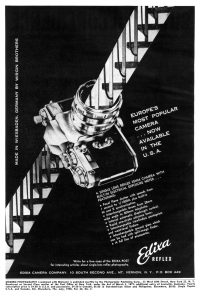
To anyone new to collecting today, a brand name that you don’t always come across is Wirgin. Wirgin was a camera manufacturer based out of Wiesbaden, West Germany, and was founded in 1920 by Jewish brothers Heinrich (Henry) and Josef Wirgin. At the time, Henry was 23 years old and had a business background with some expertise in manufacturing. Josef was his younger brother and had a lot more knowledge in the technical areas. Together, their original goal was to import cameras into Germany and sell them under the Wirgin name. At some point later, two more Wirgin brothers, Max and Wolf joined the company. Max had a chemistry background and Wolf took care of the finances.
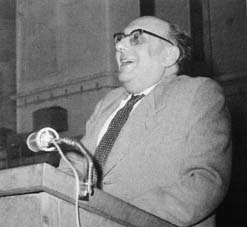
Before I go any further, just let this sink in for a moment. Jewish brothers….Nazi Germany….
It’s probably no surprise that digging up accurate information regarding the history of Wirgin is a bit difficult. Both the Camera-wiki and Camerapedia articles for Wirgin are almost word for word the same. Most other sites that mention any part of their history usually recite the same facts from these articles. Further complicating matters is that in 1938, the Wirgin brothers fled their home country due to increasing anti-Jewish harassment, and sold their entire business (another site says the factory was confiscated, not sold) to another German camera company called Adox, but bought it back after the war.
During my research into the history of Wirgin, I came across a couple of other German language sites with more information than what is available on either Camera-wiki or Camerapedia. A particularly interesting one was a German language site by Leif Johansen. Since my only knowledge of the German language comes from playing Wolfenstein video games and watching Indiana Jones movies, I had to rely on Google’s translate feature to translate most of the site to English.
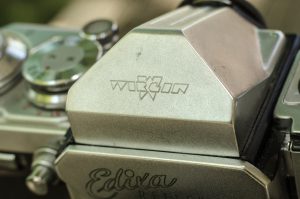
According to Johansen, in 1926 Wirgin released their first cameras which were a variety of 6.5 x 12 and 9 x 12 folding plate cameras sold under the names Gewir and Metadux. He then goes on to state that Wirgin would release a much smaller camera in 1927 that used motion picture 35mm film called the Edinex which is definitely not true. I go into the specific history of the Edinex in greater detail in my review for the Wirgin Edinex II which you can read here.
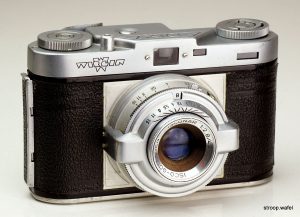
After World War II, the Wirgin brothers would return to Germany and reacquire the rights to their own company and resume making cameras. They would continue to offer some of their pre-war medium format and 35mm models, but by the 1950s, would devote their entire product line to 35mm viewfinder and rangefinder models such as the Edinex and Edixa. The Edinex series was aimed at the lower end of the market while the Edixa was more of a mid range rangefinder and view camera product line.
In 1948, Wirgin would hire a 24 year old man named Heinz Waaske who worked for them as a precision mechanic. Originally from Berlin, Heinz Waaske worked as a technician for Telefunken, which was a German radio company prior to the war. During the war, he fought in the German army and at one point was taken prisoner by Allied forces. After the war, he continued to work as a mechanic before being hired by Wirgin.
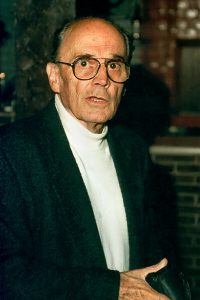
While working for Wirgin, he used his expertise and knowledge in precision manufacturing to improve upon Wirgin’s medium format cameras. Waaske improved both the reliability and cost effectiveness of various Wirgin models allowing them to be more affordable. Eventually, he would rise to the rank of chief designer and would begin work on an all new 35mm Single Lens Reflex camera. In the early 1950s, East Germany would dominate the SLR camera market with models like the KW Praktiflex and Zeiss-Ikon Contax SLR. The Japanese camera market was still in it’s infancy, and only a couple Japanese SLRs existed at the time, so this was an opportunistic time for Wirgin to release an all new SLR to capture the market.
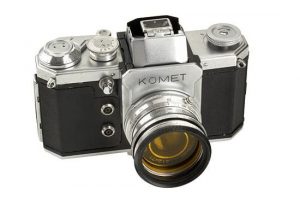
In 1954, Wirgin would release the Edixa Reflex SLR. The camera was originally to be called the Wirgin Komet, but due to a copyright claim on the ‘Komet’ name, the camera was given the name ‘Edixa Reflex possibly to associate it with the company’s successful Edixa rangefinder.
The new camera was designed primarily by Waaske and a team he hired consisting of former Praktica and Ihagee employees. It combined the best characteristics of cameras from 3 different Dresden area camera makers. It would be a full system camera like the Ihagee Exakta, it would have the interchangeable M42 screw mount of the Contax SLR, and it would have interchangeable waist level and pentaprism viewfinders like the KW Praktina. The Edixa was the first West German SLR to have a focal plane shutter and use the M42 lens mount, both features that were already common with East German SLRs.
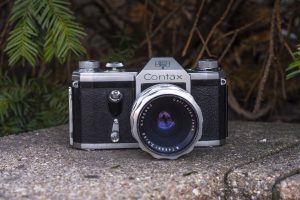
Unlike the Exakta, which at the time was Germany’s most successful SLR, the Wirgin Edixa had a much more modern interface, similar to the KW Praktica and Praktina. The front mounted shutter release and film advance lever were on the right side where a photographer today would expect to find them. The body shape was very modern with both a flat front and back and angled edges like that of the Zeiss-Ikon Contax SLR.
Since Wirgin wisely chose the M42 “Praktica” lens mount, it meant that upon it’s release, there would already be a large selection of third party lenses available for a photographer to choose from. This would prove to be a smart move versus creating their own proprietary bayonet mount.
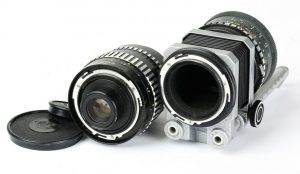
Wirgin would produce Edixa SLRs for the next decade and a half with the last model, the Edixa Electronica TL released in 1971. Most Edixa SLRs would retain the same basic body shape and most would have the M42 screw mount, with the exception being a short lived model from 1965 called the Edixa-Rex which had it’s own bayonet lens mount. Some sources online incorrectly claim that the Edixa-Rex used the Ihagee Exakta mount, which is not true. Although there were some regular M42 mount Edixas converted for use with Exakta lenses, the Edixa-Rex’s mount appears to be unique to that one model. The image to the right is the only one I’ve found showing lenses that have this unique “Rex-mount”.
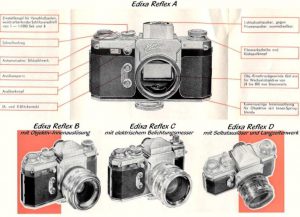
The model reviewed in this article is the Edixa Reflex B, which was part of what I call the first generation of Edixa SLRs produced between 1954 and 1959. Prior to 1957, no effort was made to differentiate between different Edixa Reflexes with different features. Starting in 1957, Wirgin began uniquely identifying them with model letters from A through D. Including the original unnamed model, there were five different models in the first generation with the following features:
- Edixa Reflex (original) – Shutter speeds 1/25 – 1/1000, no support for automatic diaphragm, no self-timer, and no meter
- Edixa Reflex A – Slow shutter speeds expanded to 1 – 1/1000
- Edixa Reflex B – Adds support for automatic diaphragm
- Edixa Reflex C – Adds uncoupled selenium exposure meter
- Edixa Reflex D – Adds self timer with slow shutter speeds as long as 9 seconds
In 1959, the Edixa SLR lineup would expand with several more models. An Edixa Reflex S would take the place of the model A with the same features, but losing the top 1/1000 shutter speed. An even simpler model called the Edixa Reflex Sv would lose the slowest 1 second shutter speed and support for automatic diaphragm lenses.
By my count, in the 1960s, at least 38 different models would be released all with confusingly similar names. Many of these different models were just the same camera with a new name, likely created for one or more export markets. At one time, there would be an Edixa Reflex, Edixa Flex, and Edixa-mat Reflex, all with different features. Some export models were sold under the name Astraflex, Revue Edixa, and Prismaflex. Highlights of the series were the Edixa-Mat in 1960 which added an instant return mirror, the Edixa-Mat-CdS in 1965 which had a CdS meter, Edixa Prismaflex in 1965 with a fixed pentaprism, and the previously mentioned Rex model with a unique bayonet lens mount and support for TTL metering.
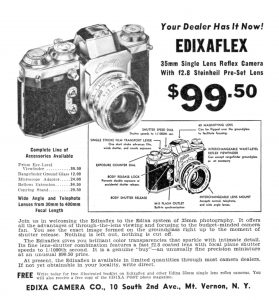
The one consistent between all Edixa models was that these were sold as ‘premium budget’ SLRs, offering features that more expensive cameras had, but at a lower cost. When it was first released, the original Edixa Reflex sold for $99.50 with a waist level finder and preset Steinheil 50mm f/2.8 lens. When adjusted for inflation, this compares to $800 today, a bargain compared to other models. I was unable to find an exact price of the Edixa Reflex B reviewed here with the pentaprism viewfinder and Quinon f/1.9 lens, but most likely the price would have been closer to $200 as that’s the same price as what the similarly spec’d Miranda A with Soligor 50mm f/1.9 sold for in 1958.
Having owned and shot several versions of the Edixa SLR, the Edixa Reflex Model B offers what I consider to be the best combination of classic all mechanical 1950s styling, with enough features to make it a fun and usable camera today.
The review below for the later Edixa-Mat Reflex Model B-L from the August/September 1965 issue of Camera 35 emphasizes the Edixa’s rugged build quality, stating that it has all of the features you need from a quality SLR without any unnecessary features. Although a later model, much of the praise offered to the Edixa would have applied to the earlier models as well. A price of $219.95 with a Schneider Xenon 50/1.9 lens confirms my guess of around $200 for the earlier model. Reading this review, if I were in the market for a 35mm Single Lens Reflex camera with good lenses and good build quality, the Edixa Reflex would have been hard to resist.

In 1962, an unrelated camera called the Edixa Electronica (not to be confused with the M42 mount Edixa Electronica TL) would be released featuring an entirely different body, using a Compur leaf shutter and a modified version of the Compur DKL lens mount, similar to the one used on the Kodak Retina Reflex and Voigtländer Bessamatic series would be produced.
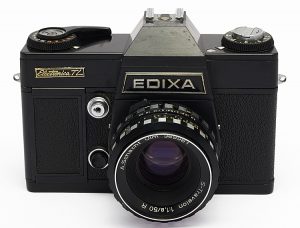
By the late 1960s, the original Wirgin company would fall into hard times and in 1968 would go bankrupt. Later that year, it would be reorganized as Edixa GmbH and would continue to sell it’s low cost cameras and lenses as bargain options. The company’s final model was introduced in 1971 as the Edixa Electronica TL, a TTL CdS metered camera with a focal plane shutter and the M42 screw mount. It would seem that too much damage was done to the reputation of the company as the model was very short lived and would be the company’s last.
In the 1970s, like they did for other extinct brands such as Miranda and Argus, Cosina of Japan would release at least one (there’s probably more), extremely basic cameras called the Edixa 2MTL. This camera used the M42 screw mount and a mechanical focal plane shutter. Although bearing the Edixa name, it should not be considered part of the series.
As was the case with a great number of other mid 20th century camera companies, the names Wirgin and Edixa would fall out of most photographers memories in the next couple of decades. With electronic cameras featuring more and more advanced features becoming common, no one was interested in a little known mechanical SLR made by an obscure company like Wirgin.
Strangely, it would be the rise of the digital camera era when collectors would start to re-remember the Wirgin Edixa Reflex. Perhaps kick-starting the brand’s resurgence as a popular camera for collectors was the following six page article called “Feed Your Edixa” which appeared in the January 31, 2004 issue of Amateur Photographer.
In it, author Ivor Matanle introduces the Edixa as a camera series with a dizzying array of models and lenses for collectors to seek out. He suggests that collecting the endless number of Edixa cameras, lenses, and accessories is the “opportunity of a lifetime” for collectors. The rest of the article serves as an excellent introduction to the key models in the Edixa lineup, calling out the brand’s good value and build quality. A bit is discussed about the rarer models like the Edixa Electronica and the bayonet Rex series. In the end, Matanle concludes, much as I have, that the Edixa is a rewarding and fun system to try and use.
Today, Edixa SLRs have a small, but very loyal following of collectors. In my experience, people who collect Wirgins, really love them for their unique looks, history, and ease of use. These aren’t the number one, two, or even tenth most popular cameras out there, but when a nice one shows up for sale, it typically sells very quickly.

My Thoughts
Back in early 2016, I picked up my first Wirgin SLR. That model was an Edixa Reflex Model C and I wrote a review for it in June of that year. That camera was in pretty rough shape. The meter was dead, the shutter would only reliably fire at 1/100 and the entire back door was missing it’s body covering. Despite those challenges, I still enjoyed shooting the camera and compared it favorably to other 1950s SLRs I had at the time.
In the years since, not only has my appreciation for Edixa SLRs grown, but the style in how I write reviews has evolved as well. I had always wanted to go back and revisit that review and update it like I’ve done with some of my other early reviews, but after getting two different, perfectly working cameras, and a couple lenses, I thought an entirely new review was more appropriate. While the majority of the images in this review are of the Edixa Reflex Model B, I also shot an equally nice Edixa-Mat Reflex Model B-L. Unless otherwise noted, everything I say for the Model B is the same as the B-L.
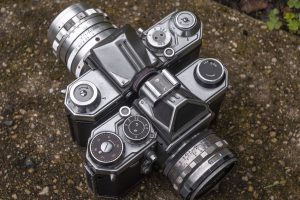
Between the two cameras, I prefer the all chrome look of the earlier Model B, compared to the B-L with black covers on the rewind knob, shutter speed dial, and exposure counter. The layout of the controls is mostly the same however, with the large and easy to use rewind knob on the left, and equally large shutter speed dial with fast speeds from 1/25 (1/30 on the B-L) to 1/1000 on top, and a separate lever for speeds from 1 second to 1/8 on the bottom.
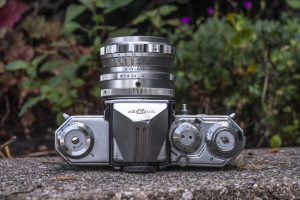
The film advance lever on both cameras shares the same shape with comfortable round tip on the end. Advancing the film on the Edixas has a firm, but not tough feel. There’s just enough tension that you can tell something is happening, without it feeling gritty or overly difficult. Only the later Model B-L has an instant return mirror, so winding the lever on the earlier Model B also lowers the mirror, but does not feel any more difficult.
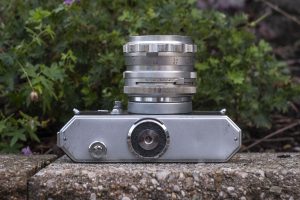
The bottom of the camera is where you’ll find the centrally located 1/4″ tripod socket which strangely sits on a raised circular pedestal like you sometimes see on TLRs. Usually cameras with raised tripod sockets are there to increase strength in the thin bottoms of cameras but they’re not commonly see on 35mm SLRs. This makes setting the camera down on a flat surface a little tricky since it doesn’t take much for it to flop over. The rewind button has a raised collar that matches the height of the tripod pedestal, but without anything to balance it out on the other side, it doesn’t do much for stability. To help with balance, there is a sliding foot that comes out of the socket if you need it. This is one of the few design details of the earlier Edixa SLRs that I don’t care for. Thankfully, the later cameras have a flat bottom.
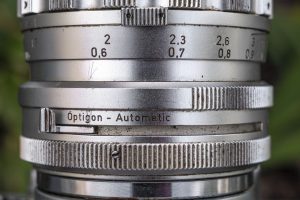
One more thing you can see from the bottom of the camera is unique to the Steinheil Quinon f/1.9 lens, which is the semi-automatic diaphragm lever. These kinds of levers were common for a short period of time with earlier semi-automatic lenses. Unlike later lenses with automatic diaphragms where the iris automatically stops down at the moment of exposure and then re-opens immediately after, the Quinon lens defaults to a preset design in which the iris is opened and closed as you choose different f/stops. For cameras like this Edixa Reflex that support the automatic diaphragm feature, you can optionally move this lever to a “cocked” position which opens the iris all the way regardless of which f/stop is selected. This allows the maximum amount of light to enter the viewfinder, making focus and composition easier, even when you need a smaller f/stop. With the lever cocked, when the shutter release is pressed, the lens will automatically stop down to your chosen f/stop at the moment of exposure like any automatic lens, but will not return open after. This lever must be manually activated every single time you want to use it.
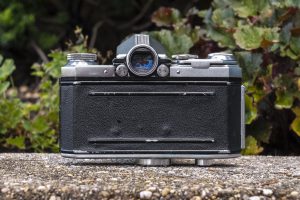
The back of the camera looks similar to most other Edixa Reflexes with two raised horizontal bars on the rear door. I am unsure of these bars are related in any way to the film pressure plate on the other side, or if they’re just a cosmetic detail. Whatever the case, they break up the monotony you often see on the backs of many 35mm cameras.
You’ll also note two round circles to the left and right of the main viewfinder, which are the releases for the interchangeable viewfinder. To remove the viewfinder, you press both circles outward and then slide the viewfinder along a track towards the back of the camera. I prefer cameras that use a sliding track like this, compared to others like the Ihagee Exakta and Nikon F which lift up. For me, sliding it out seems more secure and intuitive.
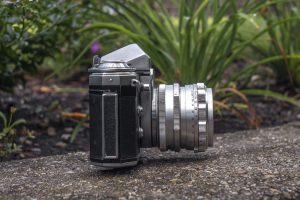
The right side of the camera is where you’ll find the latch for releasing the film compartment door release. From the side, you also get a good look at the chunkiness of the Steinheil Quinon lens. Also note, that the raised tripod socket pedestal I mentioned earlier gives the illusion that the camera is floating off the surface!
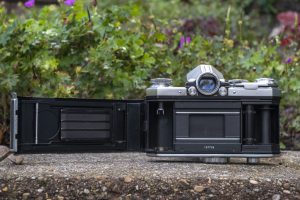
The left hinged film door reveals a mostly normal film compartment. The presence of a left hinged door on a camera with left to right film transport is unusual because it is generally better to have the latch on the side of the camera with the supply cassette rather than the take up spool because if the door is accidentally opened with film loaded, more light will leak onto exposed images on the take up side, than if it happened on the the supply side. Of course you should just never let this happen, but it does happen and as we saw with nearly every 35mm SLR that came later in the 20th century, most doors were right side hinged.
The film pressure plate is unusual too, with three rows of a recessed matte finish separated by four narrow smooth raised edges. This likely was done as a way to reduce resistance on the film as it transports through the camera, but is unlike any other I’ve seen. There is also a film roller on the take up side to help with film flatness, and curiously, a large recessed circle in the door behind it, which does not appear to have any purpose. Whether this was put there for some unused feature of the camera is anyone’s guess.
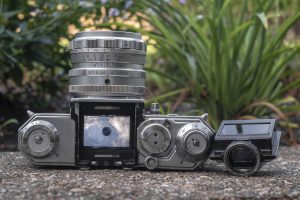
As is the case with most 35mm SLRs with interchangeable viewfinders, the pentaprism viewfinder can be removed and the camera used at waist level. Although a waist level finder is available, it’s nothing more than a folding hood to block out light. The camera can be used without it for the occasional shot.
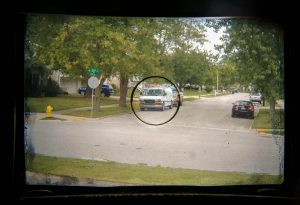
The viewfinder is mostly frosted glass with a large and very contrasty split image focus aide in the center. The whole image is pleasantly bright, especially when compared to other early SLRs. In the image to the right, I have the f/1.9 Quinon lens mounted, but even comparing it with the f/2.8 Westanar, brightness is nearly the same with only slightly more vignetting visible in the corners. I’ve commented many times on this site how I much more prefer split image focus aides as opposed to microprism circles and collars and find focusing on the Edixa very easy, even in low light.

Up front, one of my favorite features of the Edixa is the location of the shutter release. As is the case on other cameras like the Miranda and Topcon RE Super, having a front mounted shutter release allows for a smoother shutter release, especially at slow speeds, since you are pressing the camera into your face, as opposed to a top shutter release in which the shutter release motion is downward. This is a minor detail that some people may not appreciate as much as I do, but for me, these front shutter releases feel very natural for my shooting style.
The shutter release is externally threaded so that a Leica style cable release can be attached. To the left of the release is a sliding lock to prevent accidental releases of the shutter release while the camera is stored.
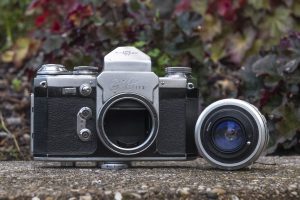
Almost all Edixa SLRs use the M42 Universal Screw Mount, the same one used by Zeiss-Ikon on their Contax/Pentacon SLRs, the KW Praktica, and eventually Pentax, Yashica, and other Japanese SLRs. One thing you’ll notice about nearly all lenses made specifically for the Edixa is that they actually say “Edixa” somewhere on the trim ring, for example the Edixa-Travegon or the Schneider Edixa Xenar. The reason for this is that there is a subtle difference in the orientation of the mount that only has an effect on lenses that support an automatic diaphragm. I’ll explain this in greater detail later in this article, but whether you use an Edixa specific lens, or any of the millions of other M42 lenses, they all mount the same, and will properly focus correctly.
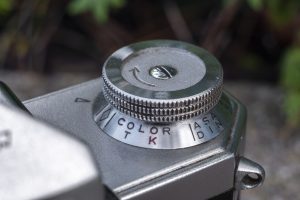
The Edixa Reflex SLR was built in an era that pre-dates the widespread use of plastic in it’s construction. Although this adds to the weight of the camera, you’re rewarded with attractive metal details like the engraved film reminder dial under the rewind knob and textured knurls on nearly every contact point on the camera.
The tactile appeal of this camera is undeniable, but how is it to shoot and what kinds of images does it make?
Edixa M42 Screw Mount Lenses
Earlier in this article I commented about how many lenses made specifically for the Edixa will have the name “Edixa” somewhere on the trim ring. The reason for this is that although the Edixa does use the “universal” M42 screw mount, the orientation of the lens mount on the camera is rotated by about 10 degrees from that of most other M42 mount cameras.
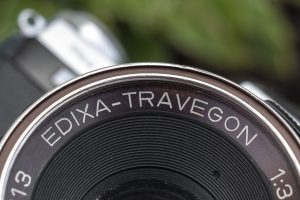
This does not affect the compatibility of non Edixa lenses on the Edixa body as any Asahi Takumar, Carl Zeiss Tessar, or Yashinon M42 lens will physically mount and since the flange to focal distance is the same, these lenses will properly focus to infinity with no issues.
Where there is a difference however, is in the compatibility with the automatic diaphragm feature which uses a combination of a pin on the lens and a paddle at the bottom of the mirror box. With a compatible lens attached, the iris remains wide open regardless of whatever f/stop on the lens is chosen. When the shutter release is pressed, the paddle will move forward and push the pin on the lens stopping it down.
In order for this to work, the pin needs to be in the exact 6 o’clock position at the base of the lens mount for the paddle to fully engage it. Since Edixa lenses are rotated by about 10 degrees, this pin is not in the correct position for the automatic diaphragm to work correctly. Sometimes the iris will stop down partially, but not all the way. Only with an Edixa-specific lens attached which counters this 10 degree rotation will the pin be in the correct position.
The easiest way to see how this works is in the image above showing both an Edixa SLR and a Sears/Ricoh TLS SLR with both Edixa and Rikenon M42 lenses.
The four quadrants of the photo show both bodies with both lenses mounted and in the top two, both the Edixa and Sears/Ricoh cameras have their correct lenses mounted. Look closely at the focus index mark (triangle on the Edixa lens and red line on the Rikenon lens). In both cases where the correct lens is on the correct camera, the index mark is at or very near top dead center.
In the bottom two images where I reverse the lenses, when the Rikenon lens is mounted to the Edixa body, the index mark is off to the left (clockwise from front), and with the Edixa lens on the Sears/Ricoh body, the index mark is off to the right (counterclockwise from front).
Why this change was done is anyone’s guess. Did someone at Wirgin purposely do this so that lenses from other manufacturers couldn’t be properly used or was it an accident? You would think that if it was an accident, it could have easily been corrected as all that would have required was a rotation of the lens mount. Then again, if Wirgin didn’t want people using other lenses on their camera, why not just go with a unique mount in the first place? Whatever the explanation, know that you can mount a non Edixa lens to an Edixa body and the images will come out great, but if you’re relying on the automatic diaphragm and your images are coming out over exposed, this is likely why that is happening.
My Results
The Edixa Reflex was a camera I shot a number of times in late 2019 and early 2020. In it I used a couple rolls of Fuji 200 and 400, and maybe even a roll of Kodak Gold 200. I switched lenses between a, Edixa-Westanar 50mm f/2.8 that came with it, a 35mm f/3.5 A.Schacht Travegon and later the 55mm f/1.9 Quinon which I bought separately from this camera at a local estate sale. I had originally wanted to complete this review after shooting the Westanar and Travegon lenses, but after getting the Quinon, I wanted one more roll.
I’ll say it now, I think Wirgin Edixas are gorgeous, especially the earlier models with chrome barrel lenses. There’s something about the thickly ribbed controls around each of the lenses made for it, the nicely designed film advance lever with the round tip, the lines across the prism and back of the camera. Where most Japanese camera makers usually went with clean lines and purposeful controls, the Germans decorated their cameras much like they built them, with a little bit of excess.
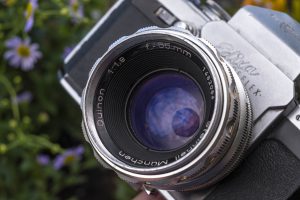
Wirgin Edixas aren’t just pretty either, their ergonomics are excellent. The camera is the perfect size for my hands, not too big and not too small. The front shutter release is in a perfect position, whose inward motion means you can squeeze the body into your face, rather than downward like a top shutter release, helping you to stabilize it better. This is one of the reasons I adore the Topcon RE Super and Miranda SLRs so much.

Despite my infatuation with their looks and excellent ergonomics, they’re not perfect. Like any camera that’s more than half a century old, these things aren’t always in the best shape when you find them. Wirgins were sold as discount cameras to non professionals who likely didn’t take care of them as well as the pros did and many are found in various stages of disrepair.
Shutter curtains can tear, mirror linkages can break, and in the case of the metered models, they often lose their sensitivity to light. For some reason, Wirgin Edixas seem to always have body covering that’s either missing or badly peeling, especially from the back. Whatever adhesive was used when these cameras were made, has definitely fared poorer than on other brands. These aren’t cons that other 1950s SLRs wouldn’t also have of course, but something you’ll want to keep in mind before getting overly excited at my excellent review and rushing out to buy one of your own!
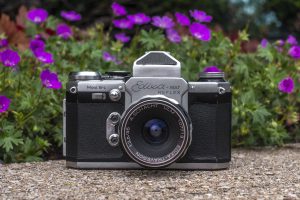
Edixa viewfinders aren’t as bright as later SLRs from the 70s and 80s, but compare favorably to other cameras of the era with a fast lens attached. With slower lenses like the f/3.5 Travegon, things get really dark in all but bright sunlight which caused me to struggle with focus. Brightness is better with the f/2.8 Edixa-Westanar and tops out with the f/1.9 Quinon, as it’s larger opening allows more more light to illuminate the focusing screen.
Looking at the images in the gallery above, the ones shot with the f/1.9 Quinon turned out the best. The f/2.8 Edixa-Westanar suffered from some internal haze which softened the images and lowering contrast, and the f/3.5 Travegon was just soft to begin with, showing the discount roots of these lenses.
Stupid me had a lens hood screwed to the front of the wide angle lens while shooting it, which darkened the corners in every image I shot with it (the Dodge Caravan and swimming pool). I can’t blame the lens for my mistake, but it’s worthwhile to point out, that the lens makes the viewfinder so dark, I couldn’t tell the difference between darkness in the corners from the hood and what was already there.
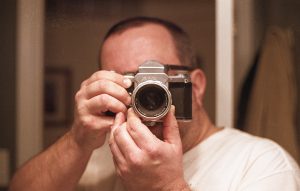
The f/1.9 Quinon was the clear winner of the three, not just because of it’s faster speed, and improvement of viewfinder brightness, but I’d say the sharpness and color rendition is on par with other early screw mount lenses by Zeiss and Asahi Optical. I was wise to postpone this review until after being able to shoot that lens.
It’s easy to see why people collect Wirgin SLRs. These cameras have the right balance of classic German looks with modern ergonomics. Although some of the lenses I shot with mine were a bit soft, keep in ind that this camera works with other M42 lenses by Zeiss, Asahi, and a slurry of other companies, so had I mounted a Tessar or a Super-Takumar lens, I likely would have gotten the same quality of results as I might have with any other screw mount SLR.
The Edixa Reflex B is one of my favorite cameras in my collection not because of it’s performance, but for me, it represents everything I love about this hobby. It’s an attractive and cool looking camera, with a great history, excellent ergonomics, and is capable of great results. There are certainly cameras that were more historically significant and those who perform better, but there’s not too many that can check off all the right boxes like this. Highly recommended!
Related Posts You Might Enjoy
External Links
https://en.wikipedia.org/wiki/Edixa_Reflex
https://simonhawketts.co.uk/2015/05/29/edixa-mat-reflex-b-slr-camera/
https://casualphotophile.com/2019/02/26/wirgin-edixa-reflex-b/
https://vintagecameralab.com/wirgin-edixa-flex/
https://johns-old-cameras.blogspot.com/2016/06/edixa-mat-reflex-mod-b.html
http://www.collection-appareils.fr/x/html/appareil-11821.html (in French)
http://web.archive.org/web/20161113192105/http://www.ukcamera.com/classic_cameras/wirgin2.htm (archived)
http://www.schaum-holzappel.de/wirgin/reflex_a.html (in German)

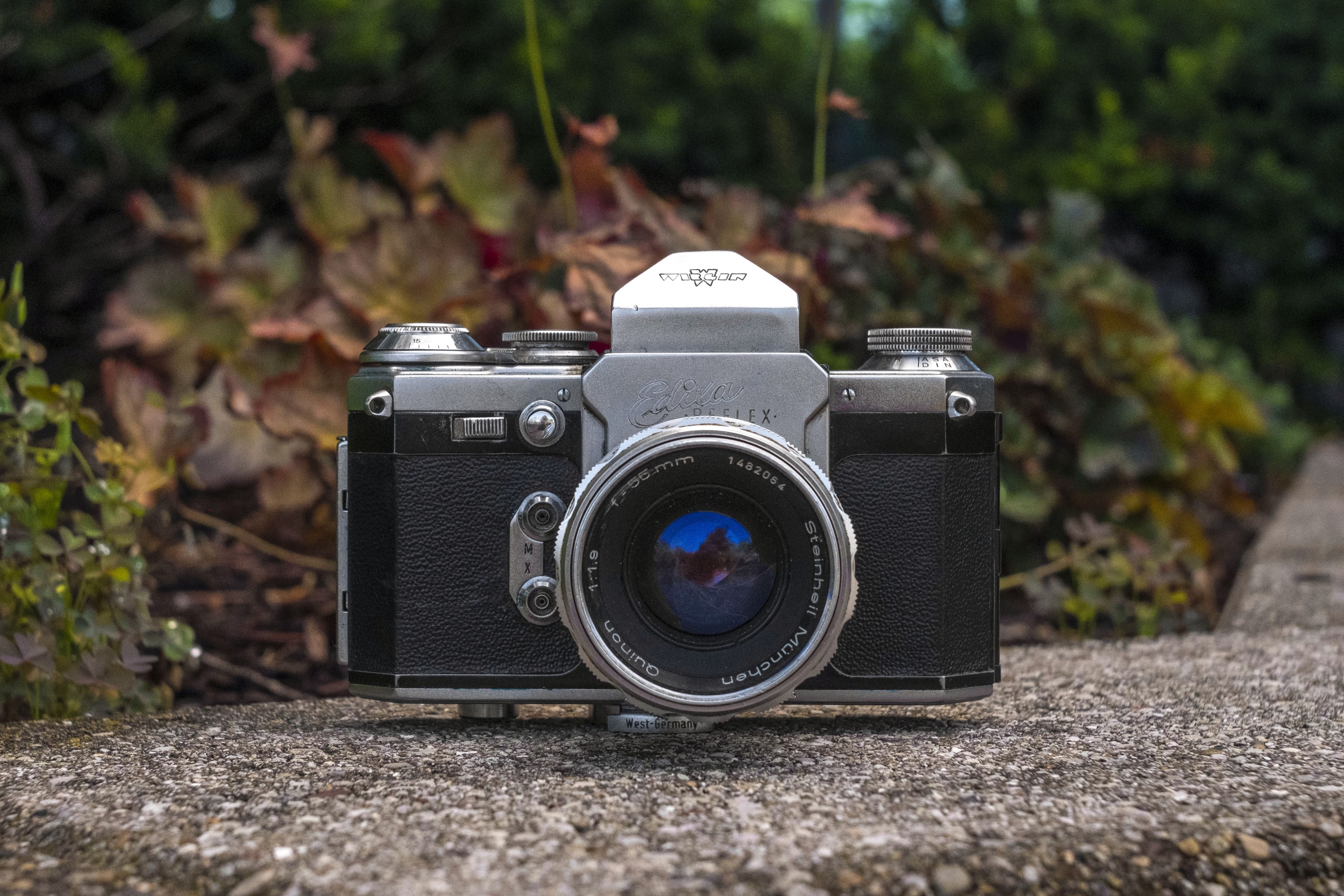
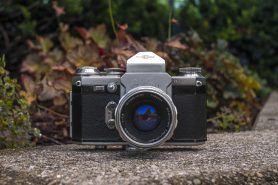
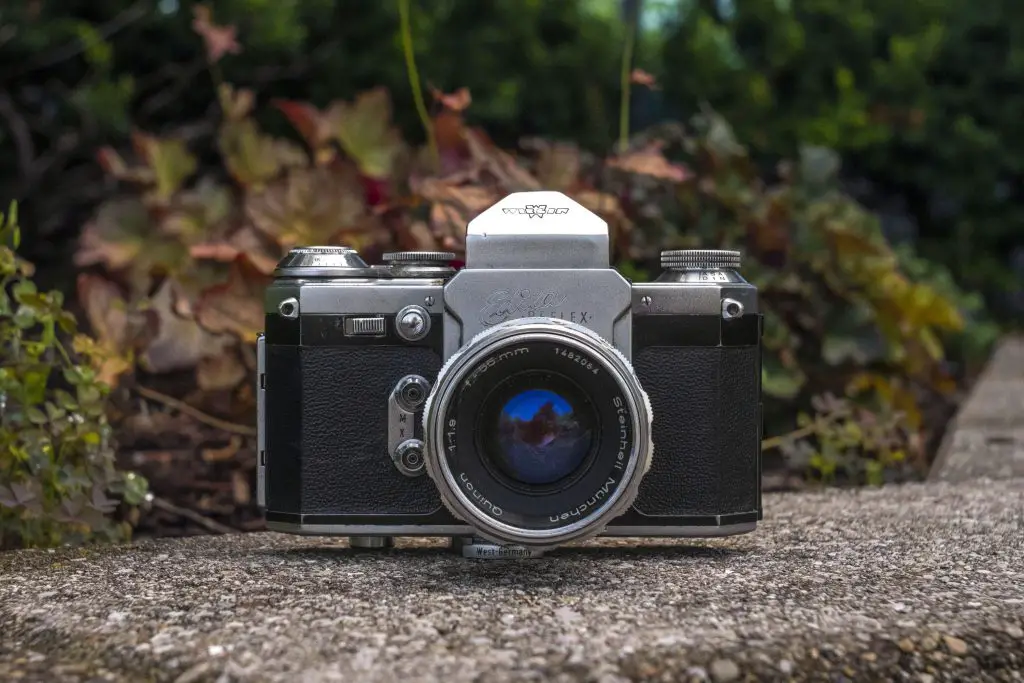
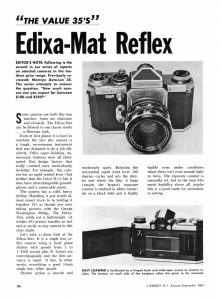

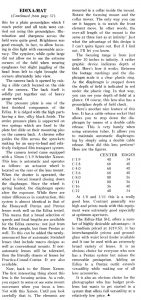
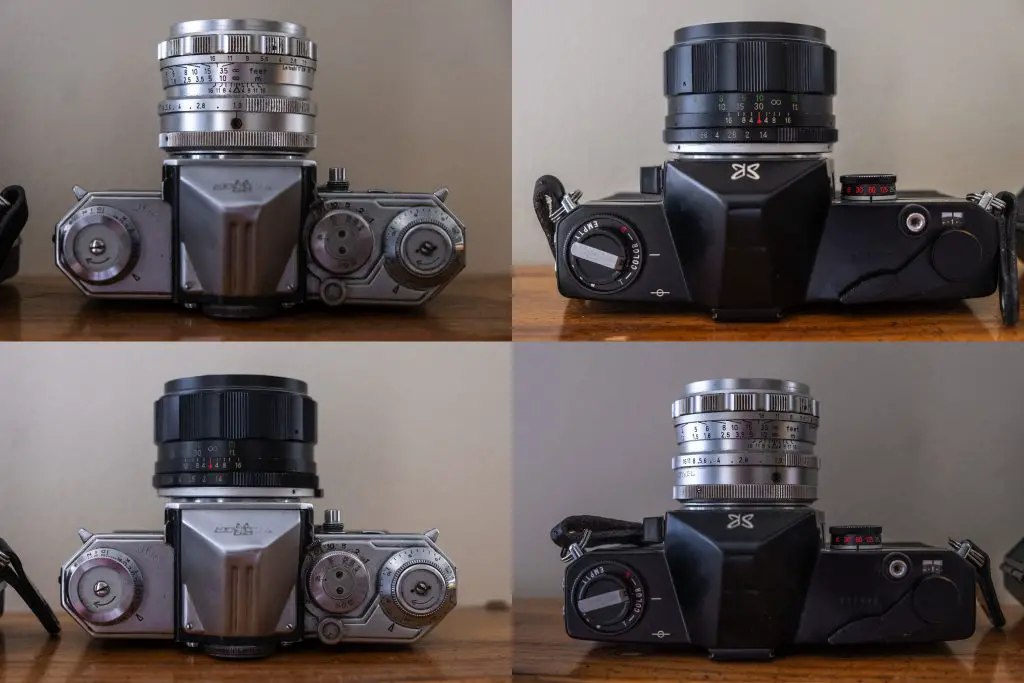






















When I was in college in the late 1960’s, I saw what I think was an Edixa B-L, owned by a fellow dorm-mate. It had the black dials of the later Edixa, and had been owned by the fellow’s older brother, a U.S. Navy man, then stationed in Germany. By this time, I was using a Nikkormat FTN, and M42 screw mount cameras were of little interest to me, though the peeling leatherette of certain cameras was noteworthy.
I can see why he had just the 50mm f/1.9 Steinheil Quinon lens, as I’d heard rumors about M42 incompatibility back then. If you make your camera body incompatible with Japanese M42 lenses, what do you think is going to happen with sales once word-of-mouth gets around? In any case, it was rare to see Asahi Pentax M42 lenses mounted on certain German 35mm SLR cameras.
This “characteristic” of the “M42 Universal” mount system kept me in the bayonet-mount worlds of Nikon, Canon, and Minolta.
I wish I could find out why Wirgin went with the slightly cocked M42 mount on the camera. Was it done on purpose to encourage people to buy Edixa specific lenses, or was it done on accident and this was their fix? Looking back at the 20th century camera industry, there’s a cautionary tale of dozens of camera makers who went in on their own unique lens mounts that were not successful. Think of how many proprietary rangefinder and SLR mounts might have been more successful had they used a more widely accepted lens mount. Did these companies actually think that people would keep buying new lenses over and over, every time they wanted a different camera?
Steinheil’s lenses are well-respected in the Exakta community, the Auto-Quinon 55mm f1.9 and the Auto-Quinaron 35mm f2.8 being two favorites. Despite the problematic Exakta bayonet mount and the external stopdown / release button, these command high prices on That Auction Site to this day … not quite in Angenieux territory, but close enough. Thanks for a very interesting review!
Based on what I’ve seen from this Quinon, I can see why. That’s not to say that Zeiss or Schneider lenses aren’t also capable of excellent results, but to have a lens that performs just as well by a “lesser known” company, I can see the appeal in that.
My wife started her professional photography career with an Edixa. It broke a couple of times (though one might be fine with the lighter use we give film cameras now), she often forgot to stop down preset lenses, and found it hard to focus. Beginner learning curve may have accounted for some of the dislike, but she was much happier when she got the Nikon F and uses their system today (Df here fave). The Edixas are indeed great looking.
Yashica, at least in their earlier M42 cameras, followed the Edixa style for their lens mount. I have a Reflex 35J, and a J-P whose lenses mount with the focus index mark 10 degrees off on a Pentax.
A possible reason for the Edixa’s offset lens mount is that there were some automatic lenses available for the original Edixa Reflex with a shutter release coupling arm similar to Exakta–in which case, perhaps this mount design was continued to allow compatibility with these lenses. It seems inconsistent even between different Edixas, though, with some of the later models seemingly having standard M42 mounts. As far as using Japanese, Soviet, or German non-Edixa automatic M42 lenses on Edixa bodies, they really need to be tried on a case-by-case basis to ensure proper functionality. Likewise, Edixa-specific lenses may mount offset when used on other M42 cameras.
What you say is possible but I doubt it. I think this was an intentional part of the design so that lens makers could sell lenses specifically branded for the Edixa. I agree with your last part though, the only way to know for sure if a lens will work 100% correctly is to try it as there are definitely differences in tolerances of any screw mount lens.